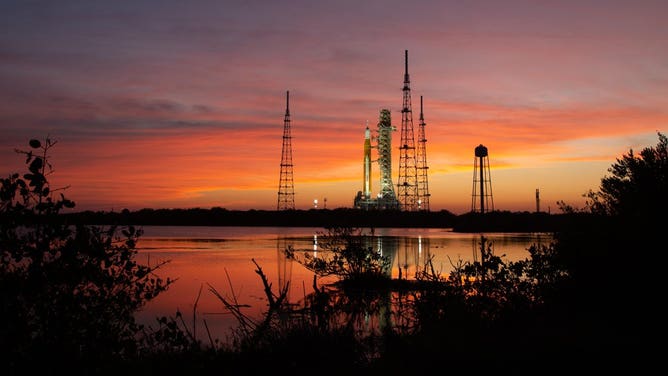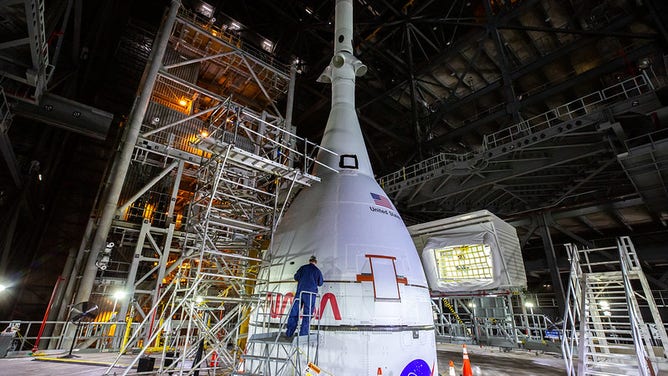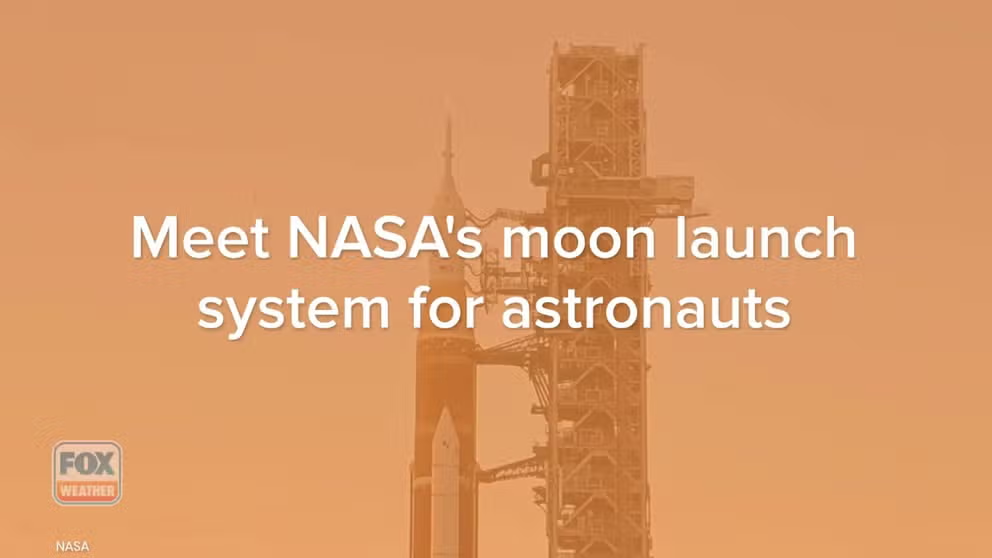Artemis-1: NASA targets Aug. 29 maiden launch of mega moon rocket from Florida
NASA released three possible launch dates: Aug. 29, Sept. 2 and Sept. 5

The Artemis I ahead of a wet dress rehearsal test attempt in April. NASA complete the test in June and is now targeting an August launch.
(NASA)
NASA said on Wednesday that its engineers continue to prepare the Artemis-1 moon rocket for a late August launch from Kennedy Space Center in Florida.
The space agency is working toward the maiden voyage of the 32-story-tall Space Launch System, which will lift off from launchpad 39B sending the crewless Orion spacecraft to orbit the moon.
Agency managers revealed on Wednesday that NASA is targeting no earlier than Aug. 29 to launch the SLS and Orion from Kennedy Space Center. The space agency also has Sept. 2 and Sept. 5 as backup launch dates.
Here are the tentative launch and return dates for Orion if the current timeline sticks:
- Aug. 29: 2-hour launch window opens at 8:33 a.m. ET. After orbiting the moon, Orion would splash down in the Pacific Ocean on Oct. 10.
- Sept. 2: 2-hour launch window opens at 12:48 p.m. ET. With this launch date, Orion would return to Earth on Oct. 11.
- Sept. 5: 90-minute launch window opens at 5:13 p.m. ET. Orion would splash down on Oct. 17.
About a week ahead of liftoff, NASA will firm up the launch date.
"We'll make the agency commitment at the flight readiness review just a little over a week before launch," NASA Associate Administrator for Exploration Systems Development James Free said. "But these are the dates that the team is working to and has a plan to. That has a lot of work left of things that we'll have to do and probably learn from, including closeouts. We'll have to make some decisions."
NASA managers stressed on Wednesday in a call with reporters that there is still a lot that needs to be done to prepare the massive moon rocket for its first spaceflight.
"We're trying to make sure that everybody understands this is the first time that we're going to try and launch his vehicle," Free said. "We're going to be careful."
BACK ONLINE: COMMUNICATIONS RESTORED WITH NASA MOON SPACECRAFT
In June, the SLS was loaded with 700,000 pounds of cryogenic fuel and launch control took the rocket through a test countdown known as the wet dress rehearsal. After NASA managers declared the test a success, the SLS and Orion were rolled back to the Vehicle Assembly Building to prepare for the Artemis-1 test flight.
Learn about NASA's new moon launch system
NASA's SLS and Orion will return humans to the moon by 2025.
Last week, engineers working to repair a hydrogen leak discovered during the wet dress rehearsal identified a loose-fitting valve known as a collet within the rocket's engine section that must be fixed. Technicians also replaced seals on the quick liquid hydrogen disconnect and continue to work on other launch preparations.
WATCH LIGHTNING STRIKE NEAR A MASSIVE SPACE ROCKET IN FLORIDA
The upcoming launch window is based on the alignment of the Earth and moon, among other criteria. NASA posted a list of all the launch windows through the end of the year.
In late June, the NASA Exploration Ground Systems Program senior vehicle operations manager Cliff Lanham estimated six to eight weeks of work lay ahead once the SLS is back inside the hangar.
Preparations for the Orion spacecraft also continue inside the VAB. Teams recently installed a video system called Callisto developed by Lockheed Martin, Amazon and Cisco to provide video aboard the test flight to the moon.
Goals of Artemis-1 test flight

The Artemis I Orion spacecraft, secured on the Space Launch System (SLS) and enclosed in its launch abort system, is in view high up in High Bay 3 of the Vehicle Assembly Building at NASA’s Kennedy Space Center in Florida on Jan. 10, 2022. (Photo credit: NASA/Corey Houston)
Artemis mission manager Mike Sarafin explained that the primary objective during the Artemis-1 test flight is to demonstrate the ability of the Orion spacecraft's heat shield to protect the spacecraft – and its future crews – from lunar re-entry.
"When Orion returns from the moon, we'll be traveling about 24,500 miles an hour, or Mach 32, and experience temperatures half as hot as the sun outside the heat shield," Sarafin said.
The heat shield has undergone extensive testing on the ground, however, no testing facility can recreate the exact lunar re-entry and return conditions, Sarafin said.
"Validating the heat shield is our primary objective and is a critical activity that we see is necessary before we fly crew on Orion on the very next mission," Sarafin said.
MEET THE MANIKINS THAT WILL HITCH A RIDE ON NASA’S MOON ROCKET
The secondary goal for Artemis-1 is to demonstrate all phases of operations from launch to spacecraft communication systems to propulsion, navigation and more.
"Orion itself will give us further confidence as a human-rated spacecraft that it can tolerate the extreme thermal environment of deep space and that we can fly in the deep space environment, including passing outbound and then returning through the Van Allen radiation belts.
The final objective is the successful re-entry and recovery of the Orion spacecraft.
When the Artemis-1 test flight happens, a crewless Orion will be sent on a path around the moon and back to Earth, splashing down in the Pacific Ocean. While no astronauts will be on board this flight, three manikins named Campos, Holga and Zohar will ride along and collect data throughout the mission.
CLICK HERE TO GET THE FOX WEATHER UPDATE PODCAST
Campos was recently loaded into Orion and is awaiting his launch.
The first astronaut flight around the moon will be known as Artemis-2, leading up to the return to the moon with Artemis-3 in 2025.
